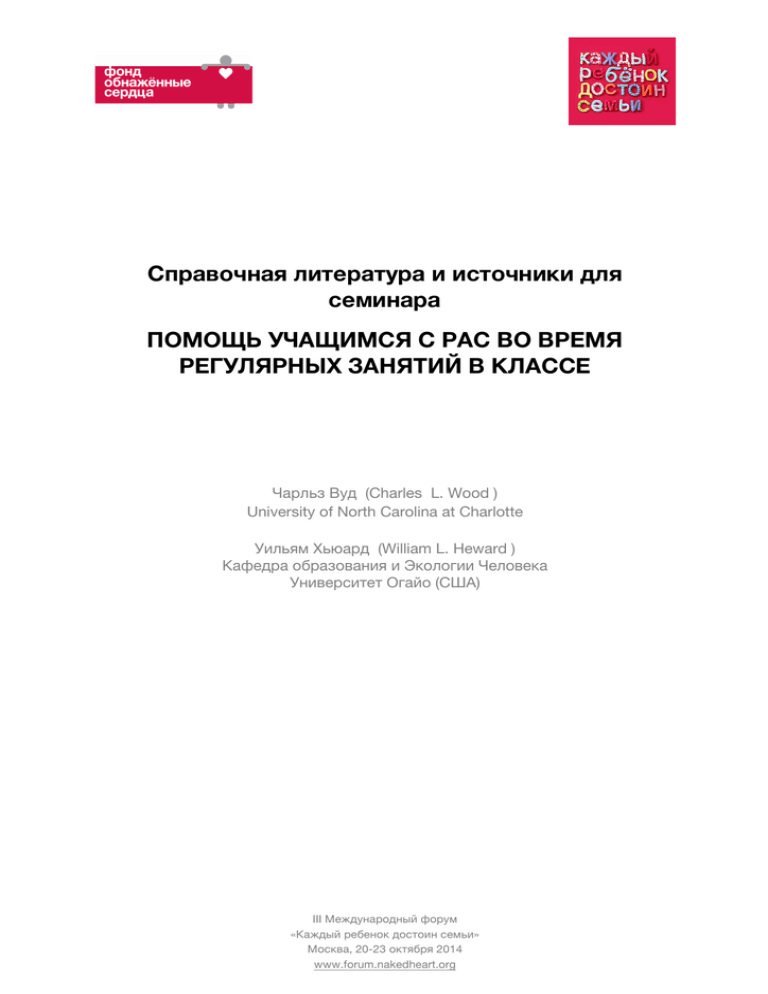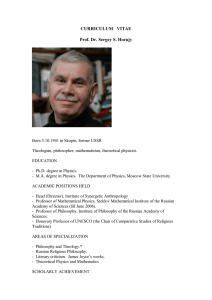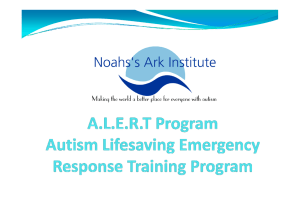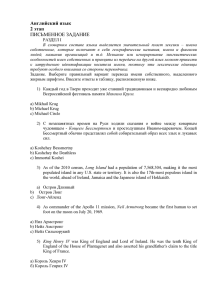Справочная литература и источники
advertisement

Справочная литература и источники для семинара ПОМОЩЬ УЧАЩИМСЯ С РАС ВО ВРЕМЯ РЕГУЛЯРНЫХ ЗАНЯТИЙ В КЛАССЕ Чарльз Вуд (Charles L. Wood ) University of North Carolina at Charlotte Уильям Хьюард (William L. Heward ) Кафедра образования и Экологии Человека Университет Огайо (США) III Международный форум «Каждый ребенок достоин семьи» Москва, 20-23 октября 2014 www.forum.nakedheart.org ТЕМЫ ДЛЯ ОБСУЖДЕНИЯ • • • • • • • Научно-обоснованные методы работы с детьми с аутизмом Активный ответ учащихся (Active Student Responding, ASR) Хоровый ответ Карты ответа Самоконтроль Стратегии сопровождения класса «Тьюторство сверстников» (ClassWide Peer Tutoring) Привлечение учителем внимания и похвала Поля, отмеченные звездочкой (*) означают, что эта презентация доступна для раздачи НАУЧНО-ОБОСНОВАННЫЕ МЕТОДИКИ ДЛЯ КОРРЕКЦИИ РАССТРОЙСТВ АУТИСТИЧЕСКОГО СПЕКТРА National Autism Center. (2009). Научно-обоснованные практики и аутизм в школах. Randolf, MA: Автор. Доступно на сайте http://www.nationalautismcenter.org/learning/ed_manual.php National Research Council. (2001). Обучение детей с аутизмом. Washington, DC: National Academy Press. National Professional Development Center on Autism Spectrum Disorders. (2013). Применение каких методов основано на фактических данных (EBP)? Chapel Hill, NC: Автор. Он-лайн модули и контрольные перечни мероприятий по внедрению доступны на сайте: http://autismpdc.fpg.unc.edu/content/ebpreviewer-training Примечания: Диаграмма, показывающая перекрытие между EBP, идентифицированными National Центром Professional Development Center on Autism Spectrum Disorders and the National Standards Информация о проекте доступна на сайте: http://autismpdc.fpg.unc.edu/content/national-standardsproject Odom, S. L., Collet-Klingenberg, L., Rogers, S. J., & Hatton, D. D. (2010). Научнообоснованные методики помощи детям и молодежи с расстройствамиаутистического спектра. Preventing School Failure, 54, 275-282. III Международный форум «Каждый ребенок достоин семьи» Москва, 20-23 октября 2014 www.forum.nakedheart.org ХОРОВЫЙ ОТВЕТ Принцип хорового ответа - когда все учащиеся в классе отвечают устно в унисон на вопрос или элемент, заданный педагогом. Данный метод используется со времен, когда все здание школы помещалось в одной комнате. Хоровый ответ (CR), самый простой и быстрый способ увеличить активное участие учеников в групповых занятиях, применялся в качестве способа ответа в многочисленных исследованиях, демонстрирующих тесную взаимосвязь между частым ASR во время обучения и улучшением результатов обучения (напр., Haydon, Marsicano, & Scott, 2013; Maheady, Michielli-Pendl, Mallette, & Harper, 2002; Sterling, Barbetta, Heward, & Heron, 1997). Данный метод успешно используется у учеников с ограниченными возможностями (напр., Cihak et al., 2006; Flores & Ganz, 2009; Kamps, Dugan, Leonard, & Doust, 1994). ХОРОВЫЙ ОТВЕТ (ПРОДОЛЖЕНИЕ) Alberto, P. A., Waugh, R. E., Fredrick, L. D., & Davis, D. H. (2013). Sight word literacy: A functional-based approach for identification and comprehension of individual words and connected text. Education and Training in Autism and Developmental Disabilities, 48, 332-350. Armendariz, F., & Umbreit, J. (1999). Using active responding to reduce disruptive behavior in a general education classroom. Journal of Positive Behavior Interventions, 1, 152-158. Blackwell, A. J., & McLaughlin, T. F. (2005). Using guided notes, choral responding, and response cards to increase student performance. The International Journal of Special Education, 20(2), 1-5. Carnine, D. W. (1976). Effects of two teacher presentation rates on off-task behavior, answering correctly, and participation. Journal of Applied Behavior Analysis, 9(2), 199-206. Charania, S. M., LeBlace, L. A., Carr, J. E., & Gunby, K. (2010). Teaching effective hand raising to children with autism during group instruction. Journal of Applied Behavior Analysis, 43, 493-497. Cihak, D., Alberto, P. A., Taber-Doughty, T., & Gama, R. I. (2006). A comparison of static picture prompting and video prompting simulation strategies using group instructional procedures. Focus on Autism and Other Developmental Disabilities, 21, 89-99. III Международный форум «Каждый ребенок достоин семьи» Москва, 20-23 октября 2014 www.forum.nakedheart.org Connell, M. C., Randall, C., Wilson, J., Lutz, S., & Lamb, D. R. (1993). Building independence during in-class transitions: Teaching in-class transition skills to preschoolers with developmental delays through choral-response-based selfassessment and contingent praise. Education and Treatment of Children, 16, 160174. Flores, M. M., & Ganz, J. B. (2009). Effects of direct instruction on the reading comprehension of students with autism and developmental disabilities. Education and Training in Developmental Disabilities, 44(1), 39-53. Godfrey, S. A., Grisham-Brown, J., Schuster, J. W., & Hemmeter, M. L. (2003). The effects of three techniques on student participation with preschool children with attending problems. Education and Treatment of Children, 26, 255-272. Haydon, T., Conroy, M. A., Scott, T. M., Sindelar, P. T., Orlando, A. (2010). A comparison of three types of opportunities to respond on student academic and social behaviors. Journal of Emotional and Behavioral Disorders, 18, 27-40. Haydon, T., Marsicano, R., & Scott, T. M. (2013). A comparison of choral and individual responding: Обзор справочной литературы. Preventing School Failure, 57, 181-188. * Heward, W. L. (2009). Designing a lesson that uses choral responding and/or response cards. Unpublished handout. Heward, W. L., Courson, F. H., & Narayan, J. S. (1989). Using choral responding to increase active student response during group instruction. Teaching Exceptional Children, 21(3), 72-75. [Reprinted in: ADI News, Winter, 1990, 9(2), 30-33.] Johnson, L. K. (1990). Password: Organizing exits from the resource room. Teaching Exceptional Children, 23(2), 82-83. Kamps, D. M., Dugan, E. P., Leonard, B. R., & Doust, P. M. (1994). Enhanced small group instruction using choral responding and student interaction for children with autism and developmental disabilities. American Journal on Mental Retardation, 99, 60-73. Kamps, D., Walker, D., Dugan, E., Leonard, B. R., Thibadeau, S., Marshall, K., Grossnickle, L., & Boland, B. (1991). Small group teaching procedures: III Международный форум «Каждый ребенок достоин семьи» Москва, 20-23 октября 2014 www.forum.nakedheart.org Programming for increasing opportunities to respond and student performance. Focus on Autistic Behaviors, 6, 1-18. Maheady, L., Michielli-Pendl, J., Mallette, B., & Harper, G.F. (2002). A collaborative research project to improve the performance of a diverse sixth grade science class. Teacher Education and Special Education, 25(1), 55-70. McKenzie, G. R., & Henry, M. (1979). Effects of test-like events on on-task behavior, test anxiety, and achievement in a classroom rule-learning task. Journal of Educational Psychology, 71, 370-374. Pratton, J., & Hales, L. W. (1986). The effects of active participation on student learning. Journal of Educational Research, 79(4), 210-215. Rose, M., & Rose, D. J. (2001). Using choral responding when learning to spell. Teaching and Learning, 22(2), 107-116. Sainato, D. M., Strain, P. S., & Lyon, S. L. (1987). Increasing academic responding of handicapped preschool children during group instruction. Journal of the Division of Early Childhood Special Education, 12, 23-30. Sindelar, P. T., Bursuck, W. D., & Halle, J. W. (1986). The effects of two variations of teacher questioning on student performance. Education and Treatment of Children, 9, 56-66. Sterling, R., Barbetta, P. M., Heward, W. L. & Heron, T. E. (1997). A comparison of active student response and on-task instruction on the acquisition and maintenance of health facts by fourth grade special education students. Journal of Behavioral Education, 7, 151-165. Tincani, M., Ernsbarger, S., Harrison, T. J., & Heward. W. L. (2005). Effects of two instructional paces on pre-K students' participation rate, accuracy, and off-task behavior in the Language for Learning program. Journal of Direct Instruction, 5, 97109. * Wood, C. L., & Heward, W. L. (2013). Good noise! Using choral responding to increase active student response during group instruction. Рукопись в работе III Международный форум «Каждый ребенок достоин семьи» Москва, 20-23 октября 2014 www.forum.nakedheart.org КАРТЫ ОТВЕТА Карты ответа представляют собой карты, знаки или другие предметы, одновременно показываемые всеми учениками в классе, чтобы продемонстрировать их ответы на вопросы или проблемы, поставленные учителем. При использовании напечатанных RC, каждый ученик выбирает из личного набора карт одну с тем ответом, который он считает нужным отобразить. При использовании записываемых RC, учащиеся применяют легко стираемые маркеры для записи своих ответов на пустых карточках, которые они стирают в промежутках между обучающими тестами. Многочисленные исследования, проведенные в общих и специальных образовательных классах начальной и средней школы, а также классов вторичного уровня, в которых координаторы сравнивали уроки с использованием RC карт и уроки с наиболее распространенным методом индивидуального опроса при обучении в группе, показали повышение степени частоты ответа учащегося, более высокую точность реагирования и более высокие баллы по результатам контрольных проверочных работ и итоговых тестов. Antrim, D. S., Miller, A. D., & Rogers, W. L. (1996). Effective questioning: A comparison of oral questioning and write-on response cards. 22nd Annual Convention of the Association for Behavior Analysis, San Francisco. Armendariz, F., & Umbreit, J. (1999). Using active responding to reduce disruptive behavior in a general education classroom. Journal of Positive Behavior Interventions, 1, 152-158. Berrong, A. K., Schuster, J. W., Morse, T. E., & Collins, B. C. (2007). The effects of response cards on active participation and social behavior of students with moderate and severe disabilities. Journal of Developmental and Physical Disabilities, 19, 187-199. Cavanaugh, R. A., Heward, W. L., & Donelson, F. (1996). Effects of response cards during lesson closure on the academic performance of secondary students in an earth science course. Journal of Applied Behavior Analysis, 29, 403-406. III Международный форум «Каждый ребенок достоин семьи» Москва, 20-23 октября 2014 www.forum.nakedheart.org Christle, C. A., & Schuster, J. W. (2003). The effects of using response cards on student participation, academic achievement, and on-task behavior during wholeclass, math instruction. Journal of Behavioral Education, 12, 147-165. Clayton, M. C., & Woodward, C. (2007). The effect of response cards on participation and weekly quiz scores of university students enrolled in introductory psychology course. Journal of Behavioral Education, 16, 250-258. Davis, L. L., & O’Neill, R. E. (2004). Use of response cards wit ha group of students with learning disabilities including those for whom English is a second language. Journal of Applied Behavior Analysis, 37, 219-222. Duchaine, E., Green, K. B., & Jolivette, K. (2011). Using response cards fas a classwide intervention to decrrease challenging behavior. Beyond Behavior, 20(1), 3-10. Gardner III, R., Heward, W. L., & Grossi, T. A. (1994). Effects of response cards on student participation and academic achievement: A systematic replication with inner-city students during whole-class science instruction. Journal of Applied Behavior Analysis, 27, 63-71. George, C. L. (2010). Effects of response cards on performance and participation in social studies for middle school students with emotional and behavioral disorders. Behavioral Disorders, 35, 200-213. КАРТЫ ОТВЕТА (ПРОДОЛЖЕНИЕ) Godfrey, S. A., Grisham-Brown, J., Schuster, J. W., & Hemmeter, M. L. (2003). The effects of three techniques on student participation with preschool children with attending problems. Education and Treatment of Children, 26, 255-272. * Heward, W. L. (2009). Designing a lesson that uses choral responding and/or response cards. Unpublished handout. * Heward, W. L. (2012). How to get your own set of response cards. Неопубликованные тексты. III Международный форум «Каждый ребенок достоин семьи» Москва, 20-23 октября 2014 www.forum.nakedheart.org * Heward, W. L., Gardner, R., III, Cavanaugh, R. A., Courson, F. H., Grossi, T. A., & Barbetta, P. M. (1996). Everyone participates in this class: Using response cards to increase active student response. Teaching Exceptional Children, 28(2), 4-10. Horn, C. (2010). Карты ответа: An effective intervention for students with disabilities. Education and Training in Autism and Developmental Disabilities, 45, 116-123. Horn, C., Shuster, J. W., & Collins, B. C. (2006). Use of response cards to teach telling time to students with moderate and severe disabilities. Education and Training in Developmental Disabilities, 41, 382-391. Kellum, K. K., Carr, J. E., & Dozier, C. L. (2001). Response-card instruction and student learning in a college classroom. Teaching of Psychology, 28(2), 101-104. Lambert, M. C., Cartledge, G., Lo, Y., & Heward, W. L. (2006). Effects of response cards on disruptive behavior and participation by fourth-grade students during math lessons in an urban school. Journal of Positive Behavioral Interventions, 8, 88-99. Maheady, L., Michielli-Pendl, J., Mallette, B., & Harper, G.F. (2002). A collaborative research project to improve the performance of a diverse sixth grade science class. Teacher Education and Special Education, 25(1), 55-70. Marmolejo, E. K., Wilder, D. A., & Bradley, L. (2004). A preliminary analysis of the effects of response cards on student performance and participation in an upper division university course. Journal of Applied Behavior Analysis, 37, 405-410. Munro, D. W., & Stephenson, J. (2009). The effects of response cards on student and teacher behavior during vocabulary instruction. Journal of Applied Behavior Analysis 42, 795-800. Musti-Rao, S., Stephen D. Kroeger, S. D., & Schumacher-Dyke, K. (2008). Using guided notes and response cards at the postsecondary level. Teacher Education and Special Education, 31, 149-163. Narayan, J. S., Heward, W. L., Gardner III, R. Courson, F. H., & Omness, C. (1990). Using response cards to increase student participation in an elementary classroom. Journal of Applied Behavior Analysis, 23, 483-490. III Международный форум «Каждый ребенок достоин семьи» Москва, 20-23 октября 2014 www.forum.nakedheart.org КАРТЫ ОТВЕТА (ПРОДОЛЖЕНИЕ) Randolph, J. J. (2001). Effects of response cards on student participation and achievement: A systematic replication with Polish students in the English as a foreign language classroom. Master’s thesis, Framingham State College, Framingham, MA. Randolph, J. J. (2007). Meta-analysis of the research on response cards: Effects on test achievement quiz achievement, participation, and off-task behavior. Journal of Positive Behavioral Interventions, 9, 113-128. Reynolds, C. M. (2003). Opportunities to respond through the use of response cards. Master’s thesis, Buffalo State College, Buffalo, NY. Schwab, J. R., Tucci, S., & Jolivette, K. (2013). Integrating schema-based instruction and response cards for student with learning disabilities and challenging behaviors. Beyond Behavior, 22(3), 24-30. Shabani, D. B., & Carr, J. E. (2004). An evaluation of response cards as an adjunct to standard instruction in university classrooms: A systematic replication and extension. North American Journal of Psychology, 6(1), 85–100. Skibo, H., Mims, P., & Spooner, F. (2011). Teaching number identification to students with severe disabilities using response cards. Education and Training in Developmental Disabilities, 46, 124-133. Swanson, P. N. (1998). An analysis of the effects of response cards, selfmonitoring, and goal-setting on the social studies achievement of students with learning disabilities. Doctoral dissertation, Vanderbilt University. Tam, B. K. Y., & Scott, M. L. (1996). Three group instructional strategies for students with limited English proficiency in vocational education. The Journal for Vocational Special Needs Education, 19, 1, 31-36. Wood, C. L., Mabry, L. E., Kretlow, A. G., Lo, Y., & Galloway, T. W. (2009). Effects of preprinted response cards on students’ participation and off-task behavior in a rural kindergarten classroom. Rural Special Education Quarterly, 28(2), 39-47. III Международный форум «Каждый ребенок достоин семьи» Москва, 20-23 октября 2014 www.forum.nakedheart.org САМОКОНТРОЛЬ Boccuzzi Legge, D., DeBar, R. M., & Sheila R. Alber-Morgan, S. R. (2010). The effects of self-monitoring with a MotivAider® on the on-task behavior of fifth and sixth Graders with autism and other disabilities. Journal of Behavior Assessment and Intervention in Children, 1(1), 43-52. Cihak, D. F., Wright, R., & Ayres, K. M. (2010). Use of self-modeling static-picture prompts via a handheld computer to facilitate self-monitoring in the general education classroom. Education and Training in Developmental Disabilities, 45(1), 136-149. Daly. P. M., & Ranalli, P. (2003). Using countoons to teach self-monitoring skills. Teaching Exceptional Children, 35(5), 30–35. * Flaute, A. J., Peterson, S. M., Van Norman, R. K., Riffle, T., & Eakins, A. (2005). Motivate me! 20 tips for using a MotivAider® to improve your classroom. Teaching Exceptional Children Plus, 2(2) Article 3. Available at http://journals.cec.sped.org/tecplus/vol2/iss2/art3/ * Heward, W. L. (2013). Self-monitoring helps students do more than just be on task. In W. L. Heward, Exceptional children: An introduction to special education (10th ed.) (pp. 398-399). Upper Saddle River, NJ: Pearson. Holifield, C., Goodman, J., Hazelkorn, M., & Heflin, L. J. (2010). Using selfmonitoring to increase attending to task and academic accuracy in children with autism. Focus on Autism and Other Developmental Disabilities, 25(4) 230-238. Joseph, L. M., & Konrad, M. (2009). Twenty ways to help students self-manage their academic performance. Intervention in School and Clinic, 44, 246-249. KidTools. Available online at: http://kidtools.missouri.edu/ Koegel, R. L., & Koegel, L. K. (1990) Extended reductions in stereotypic behavior of students with autism through a self-management treatment package. Journal of Applied Behavior Analysis, 23, 119–127. Koegel, L., Koegel, R., Hurley, C., & Frea, W. (1992). Improving social skills and disruptive behavior in children with autism through self-management. Journal of Applied Behavior Analysis, 25, 341-353. III Международный форум «Каждый ребенок достоин семьи» Москва, 20-23 октября 2014 www.forum.nakedheart.org Lee, S-H, Simpson, R. L., & Shogren, K. A. (2007). Effects and implications of selfmanagement for students with autism: A meta-analysis. Focus on Autism and Other Developmental Disabilities, 22, 2-13. McConnell, M. E. (1999). Self-monitoring, cueing, recording, and managing: Teaching students to manage their own behavior. Teaching Exceptional Children, 32(2), 14-21. Newman, B., Reinecke, D. R., & Deborah L. Meinberg, D. L. (2000). Selfmanagement of varied responding in three students with autism. Behavioral Interventions, 15, 145-151. Rafferty (2010). Step-by-step teaching students to self-monitor. Teaching Exceptional Children, 43(2), 50-58. ТЬЮТОРСТВО НАД КЛАССОМ Cooke, N. L., Heron, T. E., Heward, W. L., & Test, D. W. (1982). Integrating a down's syndrome child in a classwide peer tutoring system: A case report. Mental Retardation, 20, 22-25. ТЬЮТОРСТВО НАД КЛАССОМ (ПРОДОЛЖЕНИЕ) Fuchs, D., Fuchs, L. S., Mathes, P. G., & Simmons, D. C. (1996). Peer-assisted learning strategies in reading: A manual. Nashville, TN: Vanderbilt University. Greenwood, C. R., Delquadri, J., & Carta, J. J. (1997). Together we can: Classwide peer tutoring to improve basic academic skills. Longmont, CO: Sopris West. * Heward, W. L. (2013). Classwide peer tutoring: Collaborative learning for students with disabilities in inclusive classrooms. In W. L. Heward, Exceptional children: An introduction to special education (10th ed.) (pp. 74-77). Upper Saddle River, NJ: Pearson. Heward, W. L., Heron, T. E., & Cooke, N. L. (1982). Tutor huddle: Key element in a classwide peer tutoring system. Elementary School Journal, 83, 115–123. Kamps, D. M., Barbetta, P. M., Leonard, B. R., & Delquadri, J. (1994). Classwide peer tutoring: An integration strategy to improve reading skills and promote peer interactions among students with autism and general education peers. Journal of Applied Behavior Analysis, 27, 49-61. III Международный форум «Каждый ребенок достоин семьи» Москва, 20-23 октября 2014 www.forum.nakedheart.org Kamps, D., Dugan, E., Potucek, J., & Collins, A. (1999). Effects of cross aged peer tutoring networks among students with autism and general education students. Journal of Behavioral Education, 9, 97-115. Kamps, D., Locke, P., Delquadri, J., & Hall, R. V. (1989). Increasing academic skills of students with autism using fifth grade peers as tutors. Education & Treatment of Children, 12(1), 38-51. Maheady, L., Harper, G. F., Sacca, M. K., & Mallette, B. (1991). Classwide student tutoring teams: Instructor’s manual and videotape package. Fredonia, NY: School of Education, SUNY Fredonia. Maheady, L., Mallette, B., & Harper, G. F. (2006). Four classwide peer tutoring models: Similarities, differences, and implications for research and practice. Reading and Writing Quarterly, 22, 65-89. Maheady, L., Sacca, M. K., & Harper, G. F. (1987). Classwide peer tutoring teams: Effects on the academic performance of secondary students. Journal of Special Education, 21(3), 107–121. Miller, A. D., Barbetta, P. M., & Heron, T. E. (1994). START tutoring: Designing, training, implementing, adapting, and evaluating tutoring programs for school and home settings. In R. Gardner III, D. M. Sainato, J. O. Cooper, T. E. Heron, W. L. Heward, J. Eshleman, & T. A. Grossi (Eds.), Behavior analysis in education: Focus on measurably superior instruction (pp. 265-282). Monterey, CA: Brooks/Cole. Simpson, R. L. (1992). Tips for practitioners: Peer tutoring and students with autism. Focus on Autistic Behavior, 7(4), 16-18. Special Connections Website. (2005). Учебные материалы, связанные с тьюторством сверстников. University of Kansas. http:// www.specialconnections.ku.edu/cgibin/cgiwrap/specconn/main.php?cat=instruction&section=main&subsection=cwpt /teachertools ЗАКРЕПЛЕНИЕ ПОХВАЛОЙ УЧИТЕЛЯ И ВНИМАНИЕ Alber, S. R., & Heward, W. L. (1997). Recruit it or lose it! Training students to recruit positive teacher attention. Intervention in School and Clinic, 32, 275-282. * Alber, S. R., & Heward, W. L. (2000). Teaching students to recruit positive attention: Обзоры и рекомендации. Journal of Behavioral Education, 10, 177- III Международный форум «Каждый ребенок достоин семьи» Москва, 20-23 октября 2014 www.forum.nakedheart.org 204. Alber, S. R., Heward, W. L., & Hippler, B. J. (1999). Training middle school students with learning disabilities to recruit positive teacher attention. Exceptional Children, 65, 253-270. Connell, M. C., Carta, J. J., & Baer, D. M. (1993). Programming generalization of in-class transition skills: Teaching preschoolers with developmental delays to selfassess and recruit contingent teacher praise. Journal of Applied Behavior Analysis, 26, 345-352. Craft, M. A., Alber, S. R., & Heward, W. L. (1998). Teaching elementary students with developmental disabilities to recruit teacher attention in a general education classroom: Effects on teacher praise and academic productivity. Journal of Applied Behavior Analysis, 31, 399-415. Hrydowy, E. R., Stokes, T. F., & Martin, G. L. (1984). Training elementary students to prompt teacher praise. Education and Treatment of Children, 7, 99–180. Harchik, A. E., Harchik, A. J., Luce, S. C., & Sherman, J. A. (1990). Teaching autistic and severely handicapped children to recruit praise: Acquisition and generalization. Research in Developmental Disabilities, 11, 77–95. * Heward, W. L. (2013). The power of teacher praise. In W. L. Heward, Exceptional Children: An Introduction to Special Education (10h ed.) (pp. 218-219). Upper Saddle River, NJ: Pearson. Morgan, D., Young, K. R., Goldstein, S. (1983). Teaching behaviorally disordered students to increase teacher attention and praise in mainstreamed classrooms. Behavioral Disorders, 8, 265-273. Stokes, T. F., Fowler, S. A., & Baer, D. M. (1978). Training preschool children to recruit natural communities of reinforcement. Journal of Applied Behavior Analysis, 11, 285-303. Todd, A. W., Horner, R. W., & Sugai, G. (1999). Self-monitoring and self-recruited praise: Effects on problem behavior, academic engagement, and work completion in a typical classroom. Journal of Positive Behavior Interventions, 1, 66-76, 122. Wolford, T., Alber, S. R., & Heward, W. L. (2001). Teaching middle school students with learning disabilities to recruit peer assistance during cooperative learning group activities. Learning Disabilities Research & Practice, 16, 161-173. III Международный форум «Каждый ребенок достоин семьи» Москва, 20-23 октября 2014 www.forum.nakedheart.org


